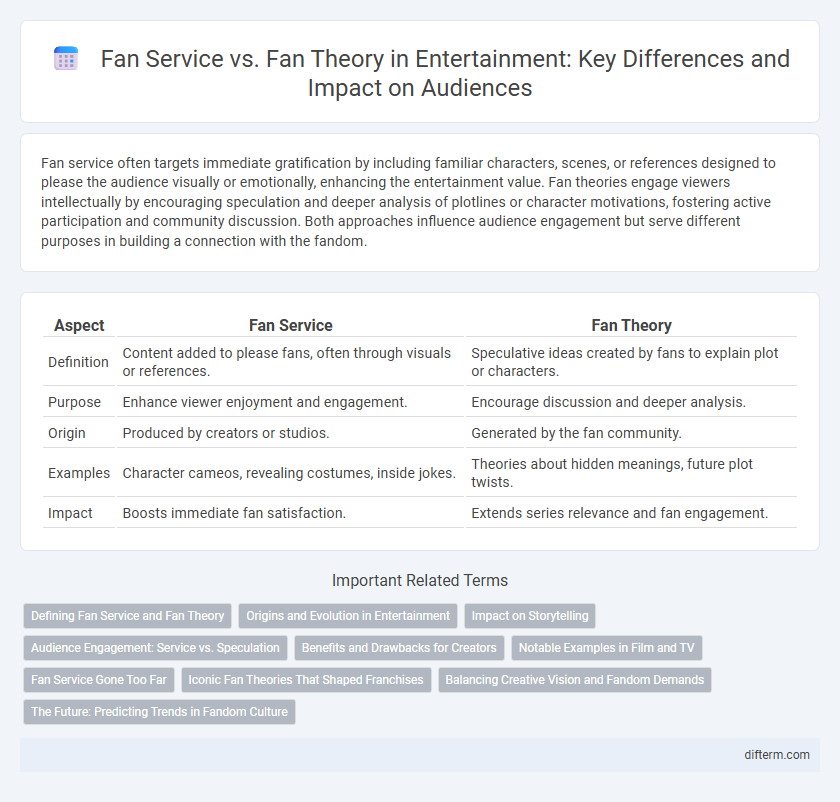Fan service often targets immediate gratification by including familiar characters, scenes, or references designed to please the audience visually or emotionally, enhancing the entertainment value. Fan theories engage viewers intellectually by encouraging speculation and deeper analysis of plotlines or character motivations, fostering active participation and community discussion. Both approaches influence audience engagement but serve different purposes in building a connection with the fandom.
Table of Comparison
| Aspect | Fan Service | Fan Theory |
|---|---|---|
| Definition | Content added to please fans, often through visuals or references. | Speculative ideas created by fans to explain plot or characters. |
| Purpose | Enhance viewer enjoyment and engagement. | Encourage discussion and deeper analysis. |
| Origin | Produced by creators or studios. | Generated by the fan community. |
| Examples | Character cameos, revealing costumes, inside jokes. | Theories about hidden meanings, future plot twists. |
| Impact | Boosts immediate fan satisfaction. | Extends series relevance and fan engagement. |
Defining Fan Service and Fan Theory
Fan service encompasses deliberate elements in entertainment designed to please and engage the audience, often including visual or narrative content tailored to fan preferences. Fan theory refers to speculative interpretations or imaginative extrapolations created by fans to explain or expand upon ambiguous plot points or character motivations. Both fan service and fan theory significantly influence fan engagement and community interaction within entertainment franchises.
Origins and Evolution in Entertainment
Fan service originated in the 1970s Japanese anime and manga to directly please audiences with visually appealing elements or familiar character moments, evolving as a marketing tool to boost viewer engagement. In contrast, fan theory emerged more prominently with the rise of internet forums in the early 2000s, allowing audiences to collaboratively interpret hidden meanings and speculate on plot developments beyond canonical material. Both fan service and fan theory shape entertainment ecosystems by deepening audience interaction and sustaining long-term franchise interest.
Impact on Storytelling
Fan service often prioritizes character moments or visual elements that satisfy audience desires, potentially disrupting narrative coherence and pacing, while fan theories engage viewers in deeper analysis and speculation, enriching the storytelling experience by adding layers of meaning and encouraging active participation. Fan service can boost immediate audience gratification but sometimes at the expense of plot development, whereas fan theories foster long-term engagement and community discussion that enhance the story's complexity and emotional resonance. The balance between these elements influences how stories evolve and maintain relevance within fan communities.
Audience Engagement: Service vs. Speculation
Fan service boosts audience engagement by delivering visually appealing or emotionally satisfying moments explicitly designed to please fans, often reinforcing established character traits or popular story elements. Fan theory, on the other hand, stimulates deeper audience interaction by encouraging speculation, analysis, and debate, driving community discussions and prolonged interest in the narrative. Both approaches enhance engagement but target different facets of fandom--immediate gratification versus intellectual curiosity.
Benefits and Drawbacks for Creators
Fan service in entertainment provides creators with immediate audience engagement and increased popularity, but risks alienating viewers if perceived as pandering. Fan theories stimulate deeper fan investment and extended discussion, offering creators valuable insights into audience interpretation without requiring direct narrative changes. Balancing fan service and fan theory allows creators to capitalize on sustained fandom enthusiasm while maintaining creative integrity and narrative coherence.
Notable Examples in Film and TV
Fan service often appears in films like "Deadpool," where direct references and Easter eggs cater to dedicated fans. In contrast, fan theories thrive around series such as "Game of Thrones," where complex narratives spark extensive speculation and debate. Both approaches engage audiences by deepening investment through different interactive layers within popular franchises.
Fan Service Gone Too Far
Fan service gone too far often undermines storytelling by prioritizing gratuitous visuals or references over coherent plot and character development. Excessive fan service can alienate viewers seeking meaningful narratives, leading to criticism for pandering rather than enhancing the entertainment value. This imbalance highlights the tension between satisfying dedicated fans and maintaining universal appeal in movies, TV shows, and video games.
Iconic Fan Theories That Shaped Franchises
Iconic fan theories have significantly shaped entertainment franchises by offering deeper interpretations that extend beyond canonical narratives, often influencing creators' future storytelling choices. Theories such as the "Steven Universe is Pink Diamond" or "The Mandela Effect in Marvel's Multiverse" enrich the fan experience by encouraging community debate and sustained engagement. These speculative narratives contrast with fan service, which targets immediate emotional satisfaction through familiar tropes or character appearances rather than expanding the intellectual scope of the franchise.
Balancing Creative Vision and Fandom Demands
Balancing creative vision and fandom demands requires understanding the distinction between fan service and fan theory, where fan service delivers direct gratification through familiar elements or character moments, while fan theories engage the audience with speculative narratives that deepen engagement. Successful entertainment franchises integrate fan service without compromising story integrity, ensuring character development and plot coherence remain central. Prioritizing narrative consistency alongside respectful incorporation of fan theories fosters a dynamic relationship between creators and fans, sustaining long-term interest and creative freshness.
The Future: Predicting Trends in Fandom Culture
Fan service continues to shape content creation by directly appealing to established audience desires through nostalgic references and character cameos, while fan theories drive deeper engagement by encouraging active speculation and community discussion around plot and character development. Emerging trends indicate a blending of these approaches where creators integrate subtle fan service elements that seed potential fan theories, fostering a participatory culture that extends the lifespan of entertainment properties beyond initial releases. This evolution in fandom culture reflects a strategic balance between immediate gratification and long-term narrative intrigue, optimizing fan investment and content longevity.
fan service vs fan theory Infographic

 difterm.com
difterm.com